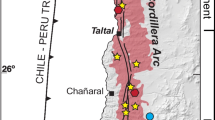Abstract
Zircon and monazite U-(Th)-Pb ion microprobe analysis were performed on the Mazeno Pass pluton and the Jutial pluton, two leucogranite bodies within the Nanga Parbat-Haramosh massif (NPHM), Pakistan Himalaya. Zircon rim ages and monazite ages indicate the Mazeno Pass pluton in southwest NPHM intruded at 1.40 ± 0.05 Ma; the Jutial pluton, to the north, similarly yields concordant zircon and monazite ages suggesting crystallization at 9.45 ± 0.06 Ma. The Jutial pluton was subsequently intruded by leucogranite dikes at 5.3 Ma, as revealed by monazite ages. Concordancy of U-Pb and Th-Pb accessory mineral ages demonstrates the robustness of the technique on young rocks. Both plutons, some of the youngest in the Himalaya, have a general association with nearby shear zones that we interpret to have played an integral role in granite evolution and emplacement setting (`deformation enhanced ascent'). Together with new field observations, these results provide an insight on the spatial and temporal relationship between plutonism and deformation relating to the development of the massif.
Similar content being viewed by others
Author information
Authors and Affiliations
Additional information
Received: 31 August 1998 / Accepted: 10 March 1999
Rights and permissions
About this article
Cite this article
Schneider, D., Edwards, M., Zeitler, P. et al. Mazeno Pass Pluton and Jutial Pluton, Pakistan Himalaya: age and implications for entrapment mechanisms of two granites in the Himalaya. Contrib Mineral Petrol 136, 273–284 (1999). https://doi.org/10.1007/s004100050538
Issue Date:
DOI: https://doi.org/10.1007/s004100050538




